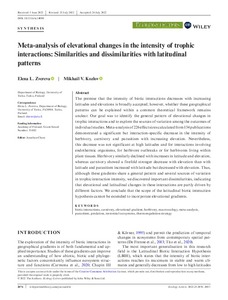Meta-analysis of elevational changes in the intensity of trophic interactions: Similarities and dissimilarities with latitudinal patterns
Zvereva Elena L; Kozlov Mikhail V.
Meta-analysis of elevational changes in the intensity of trophic interactions: Similarities and dissimilarities with latitudinal patterns
Zvereva Elena L
Kozlov Mikhail V.
WILEY
Julkaisun pysyvä osoite on:
https://urn.fi/URN:NBN:fi-fe2022091258678
https://urn.fi/URN:NBN:fi-fe2022091258678
Tiivistelmä
The premise that the intensity of biotic interactions decreases with increasing latitudes and elevations is broadly accepted; however, whether these geographical patterns can be explained within a common theoretical framework remains unclear. Our goal was to identify the general pattern of elevational changes in trophic interactions and to explore the sources of variation among the outcomes of individual studies. Meta-analysis of 226 effect sizes calculated from 134 publications demonstrated a significant but interaction-specific decrease in the intensity of herbivory, carnivory and parasitism with increasing elevation. Nevertheless, this decrease was not significant at high latitudes and for interactions involving endothermic organisms, for herbivore outbreaks or for herbivores living within plant tissues. Herbivory similarly declined with increases in latitude and elevation, whereas carnivory showed a fivefold stronger decrease with elevation than with latitude and parasitism increased with latitude but decreased with elevation. Thus, although these gradients share a general pattern and several sources of variation in trophic interaction intensity, we discovered important dissimilarities, indicating that elevational and latitudinal changes in these interactions are partly driven by different factors. We conclude that the scope of the latitudinal biotic interaction hypothesis cannot be extended to incorporate elevational gradients.
Kokoelmat
- Rinnakkaistallenteet [27094]
